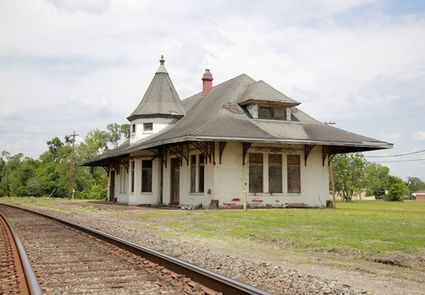The Train Depot was the Hub of Activity
Last updated 4/30/2008 at Noon
By Lula Strother Haley If one were asked to name the most important buildings in a small town, perhaps those named would be the post office, the drug store, the movie theater, etc., but it is probable that few people would include the railroad station, or “depot” as it used to be called.
In the early days, however, the railroad station was an important part of life in small towns.
Typical of these stations is the one at Orange located on Green Avenue.
It is a brick building painted white and trimmed in orange, with a pagoda-like roof and consists of a waiting room on one side for passengers and offices and a baggage room on the other.
In front is a covered area where inbound and outbound mail and baggage were handled and where passengers left or boarded the train.
During the first half of the century, before the automobile became the primary mode of travel, the depot was a link with far places, a scene of action and excitement.
Inside the station, passengers, some accompanied by friend and relative, waited for the arrival of the train.
A typical passenger was a traveling salesman, or “drummer” as he was called then.
An experienced traveler, he would check his heavy suitcase of samples and then read a newspaper while he waited.
Seen occasionally were mothers with small children, perhaps going to join a husband who had gone off job-hunting, or to visit relative.
Generally, their belongings, packed in several bags, and a shoebox lunch occupied a vacant seat nearby.
Sometimes there were sophisticated travelers -- well-dressed and carrying elegant luggage.
Outside in the covered area were several adults and children.
They were not going anywhere -- they had come to the depot just to see the trains come in.
Some of the passengers whiled away their time walking to-and-fro or watching the other passengers, the ticket agent with the green eye shade, or the telegraph operator, the constant, rhythmic ticking of this machine, an almost unnoticed sound in the back of their consciousness.
Others engaged in conversation.
Now and then someone would study announcements on the bulletin board or the train schedule chalked on the blackboard.
Trains were often late in those days and the passengers soon became bored and tired of seeing the dingy walls and the grimy floors with their spittoons.
At last, there was a stir of activity.
A man wearing a uniform cap came from the baggage room pulling a flatbed wagon loaded with baggage.
The ticket agent was busy stamping documents and the telegraph operator seemed busily intent on the da-dit-dit of his machine.
Those waiting to board the train gathered their luggage, glad at last that their wait was over.
No longer would they have to sit on the hard wooden seats, hemmed in by the heavy, steel arm rests.
Hurrying out to the covered area, they gazed in the direction from which the train would arrive.
Suddenly, they heard the faint humming of the rails.
“Here she comes,” someone shouted.
The train rounded the curved track, its steam whistle giving forth jerky blasts, its bell clanging noisily.
As it slowly approached the depot, the children waved excitedly at the engineer high up in his cab.
Then, as the train came to a stop, all eyes were fastened on the uniformed conductor as he came down from the coach placing a sort of stool for passengers to step on as they left the car.
Red caps were carrying luggage, other employees were busy loading and unloading mail and baggage.
At first everyone gazed curiously at the passengers who were leaving the train, but soon, their actions went unnoticed as the watchers turned their attention to those passengers now entering the coaches.
The conductor, after examining the tickets, helped the travelers aboard.
He picked up the stool, waved a signal to the engineer and climbed up the steps.
The excitement was reaching a crescendo.
The steam whistle sounded, and the engineer, his hand on the throttle, inched the train forward, the engine huffing and puffing, coughing and snorting, as steam hissed and smoke swirled upward from the stack.
The clamor of the bell added to the din.
Left behind; friends, relatives, and spectators began to run beside the train, waving at the people looking out the coach windows until the train gathered speed.
For a little while all had experienced, vicariously, a little of the excitement of travel.
Today, passenger trains do not stop at the Orange depot.
One must go to Beaumont to catch a train.
No longer do people go to the station to be entertained by the comings and going of travelers.
The busy, hurrying throngs go by, paying no attention to the white and orange depot.
Standing there, badly in need of another coat of paint, it has a lonely air.
















Reader Comments(0)